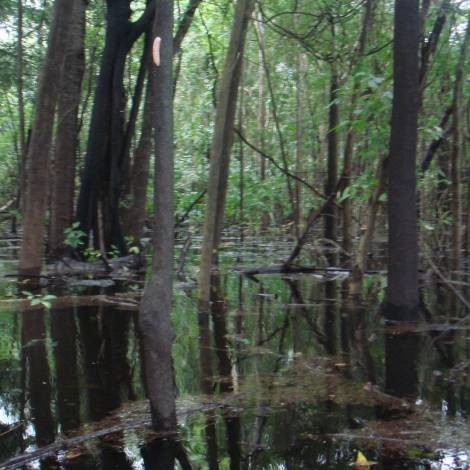Fresh air and new ideas can clean up dirty gold mining operations, and Engineering for Change is proud help make it possible. We’re lending the expertise of our global network of engineers to support the Amazon CoLab with Conservation X Labs and a global coalition of organizations promoting research and development of technologies that can end the pollution of the world’s rainforests with mercury.
All of us have used gold in our jewelry, but we also use it in things that might come as a surprise, like our phones, laptops and other devices. We’d like for that gold to be green gold.
Mercury is used to extract gold from ore panned and mined by hand by artisanal miners plying their trade in the Amazon. How bad is the problem? According to Dr. Kristin Sippl, writing in The Conversation, “Around 20% of the gold in a jewelry comes from artisanal and small-scale gold mining. And this sector is now the leading source of man-made mercury pollution in the world, emitting 727 metric tons of mercury into the environment in 2013, more than twice the amount in 2005.”
Along with Conservation X Labs, the coalition includes the United States Agency for International Development (USAID), the Gordon and Betty Moore Foundation, Microsoft, and Esri. They’re backing Amazon CoLab, a six-month acceleration program that will support teams developing solutions to protect the Amazon.
“E4C is excited to collaborate with the CoLab coalition to support the advance of these teams developing technologies to help with the mining contamination problem in the Amazon,” says Marilynn Holguin Clover, Program Coordinator at Engineering for Change who is involved in the collaboration. Ms. Holguin Clover is a biologist who has worked with mining communities to reduce pollutions in Latin America.
“It’s something we’re all a part of. All of us have used gold in our jewelry, but we also use it in things that might come as a surprise, like our phones, laptops and other devices. We’d like for that gold to be green gold. And we’d like to find solutions that can help the miners who make a living from gathering that gold for us to use,” Ms. Holguin Clover says.
The inaugural cohort of innovators in the Amazon CoLab includes six team from around the world that won the first round of the Artisanal Mining Grand Challenge that ended in 2020. These are the teams, outlined in a statement by Conservation X Labs:
ASMSpotter
Developed by dida and Levin Sources, ASMSpotter is a tool to automatically detect artisanal and small-scale gold mining (ASGM) activities using satellite data and artificial intelligence. It helps governments and conservation organizations to monitor deforestation related to ASGM activities. The solution will be tested in Guyana with the support of the Guyana Ministry of Natural Resources.
Cleangold
A mercury-free, affordable, and safe mining system that can capture finer gold particles better than mercury. The Cleangold system increases miners’ yields while helping them avoid the use of toxic chemicals. It may also be used at former mining sites to remove mercury from the environment. The solution will be tested in Peru with the support of CITE Mineria y Medio Ambiente.
Mercury Capture System
A system intending to help gold shops, NGOs, governments, and miners capture and prevent the ambient release of dangerous mercury vapor emissions in the amalgam burning process. The solution will be tested in gold shops and processing plants in the region.
Picoyune
A next-generation portable mercury sensor (including a wearable model) that will help gold shops, NGOs, miners, and industries detect contaminated spaces in real-time in the field. The solution will be tested in Guyana.
Project Inambari
A satellite image-based monitoring platform with a wide range of imagery, alerts, and analysis tools to help communities, governments and conservation groups detect mining operations in critical forest environments. The solution will be tested in Peru with the support of the Peruvian Service for Natural Protected Areas (SERNANP).
Quipu
Also known as Matokeo, this mobile-based technology system is driven by community collected data to help conservation organizations, local governments, and communities monitor mercury usage and deforestation. The solution will be tested in Peru with the support of the Alliance for Responsible Mining.
According to Conservation X Labs:
Throughout the program, participating teams will have access to a unique space for field-testing and accelerating their solutions in the Amazon basin, while connecting to implementation and testing partners in the field; experts and mentors in the business, technology, engineering, and conservation fields; and organizations and funders interested in the growth of the inaugural cohort’s solutions. The CoLab aims to advance each innovation’s application, commercial, and funding readiness levels in pursuit of adoption, financial sustainability and/or commercial success, and environmental and social impact.
This initiative is a part of The Artisanal Mining Grand Challenge, a global call for solutions to make artisanal and small-scale mining more environmentally responsible and socially equitable. The Challenge ran its first round in 2019-2020 and focused on solutions that could be applied anywhere in the world. The second round is made possible through a Global Development Alliance with the support of the Gordon and Betty Moore Foundation, Microsoft, Esri, and the United States Agency for International Development (USAID) and centers its efforts on solutions for the Amazon.
Finalists selected from the Artisanal Mining Grand Challenge: the Amazon will be invited to participate in the second cohort of the Amazon CoLab starting in April 2022.

